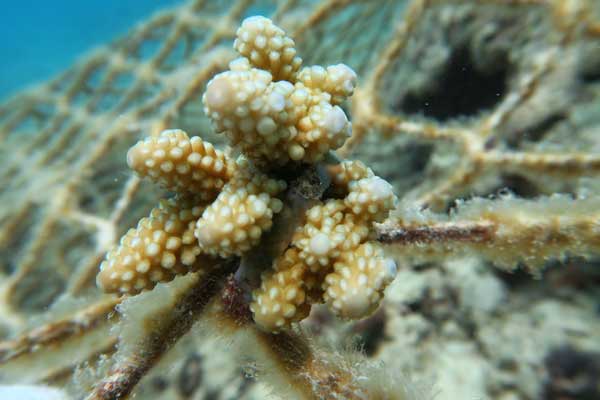Planting program helps save China's corals
Updated: 2016-06-20 08:01
By Peng Yining(China Daily)
|
|||||||||
 |
|
A coral branch transplanted to an artificial reef by scientists. [Photo/China Daily] |
"In the 1970s, we could find coral reefs 8 or 9 meters underwater. Now, the polluted water means sunlight is unable to penetrate more than 4 meters below the surface of the ocean," Huang said, referring to how many types of coral use photosynthesis to live.
She added that in 1988, when she first visited Dadonghai, a tourist spot in Hainan, the water was always clear.
"Then, I could see my toes when I stood in the water," she said. "But now, you can't see anything."
The team grows coral branches to 5 to 10 centimeters before transplanting them to waters with appropriate temperatures and levels of light, where they are attached to steel-framed artificial reefs.
The survival rate is higher than 95 percent, with the branches growing about 10 cm every year, according to Huang.
Scientists also cultivate corals by catching their germ cells (fertilized eggs) in open water.
"We usually dive around 9 pm when the corals release the cells. We wait in the cold, dark water for several hours," Huang said.
Half of her 30-strong team works at sea for at least six months of the year, living on a boat chartered by the institute.
"One year, we rented a fishing boat that had rotten fish everywhere. I slept on the deck for more than a month, and there were maggots wriggling by my pillow," she said.
Since 2009, Huang has conducted experiments to breed corals in islands in the Xisha chain, including Yongxing, Zhaoshu and Yongle.
Last year, her team established a 600-square-meter experimental zone in the Nansha Islands, where they transplanted more than 1,500 coral branches and sank 87 artificial concrete reefs.
"I am pleased to see that public awareness of coral conservation has been growing rapidly since 2009," said Chen Chang, deputy director of a science research station in Xisha run by the South China Sea Institute of Oceanology.
Today's Top News
Goals may need revision
Brexit strategy
UK Health Minister comes down on staying in the EU
China, Europe urged to set free trade timetable
Xi's visit to boost partnership projects
First Disney resort in Chinese mainland opens
Killing of policeman 'incontestably terrorist act'
Cultural exchange photo exhibition opens in Poland
Hot Topics
Lunar probe , China growth forecasts, Emission rules get tougher, China seen through 'colored lens', International board,
Editor's Picks

|

|

|

|

|

|







